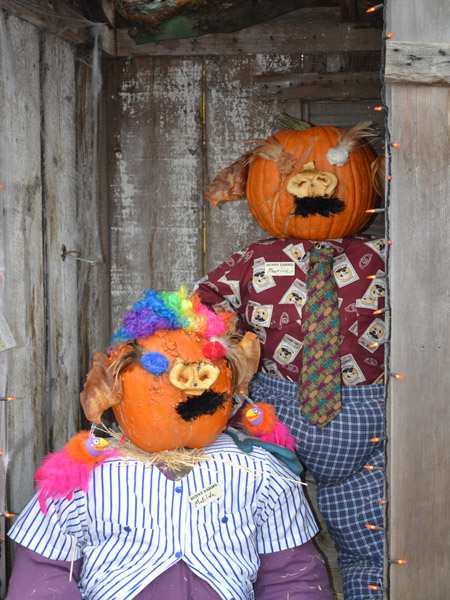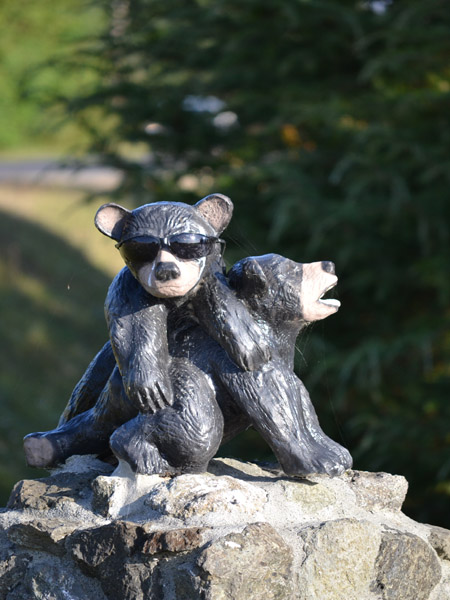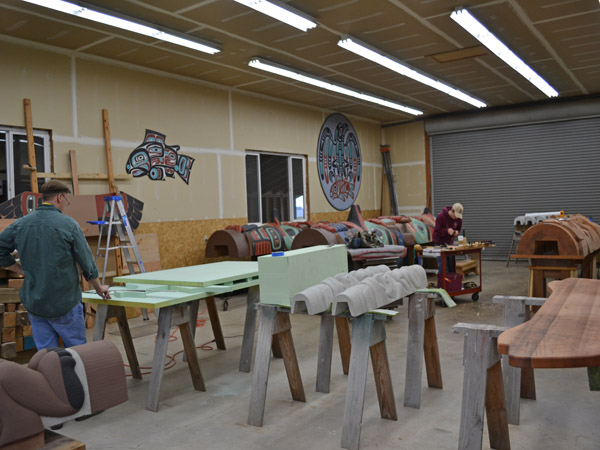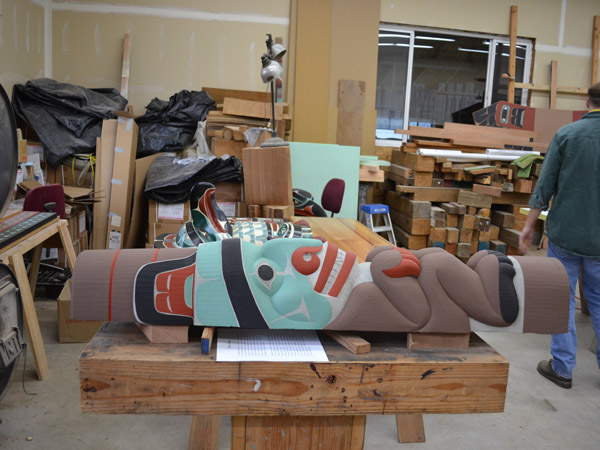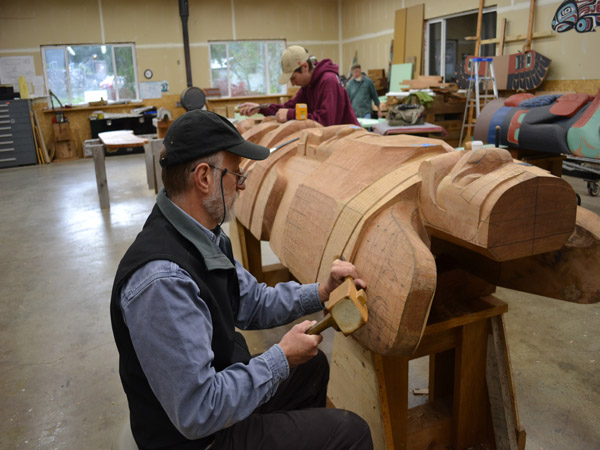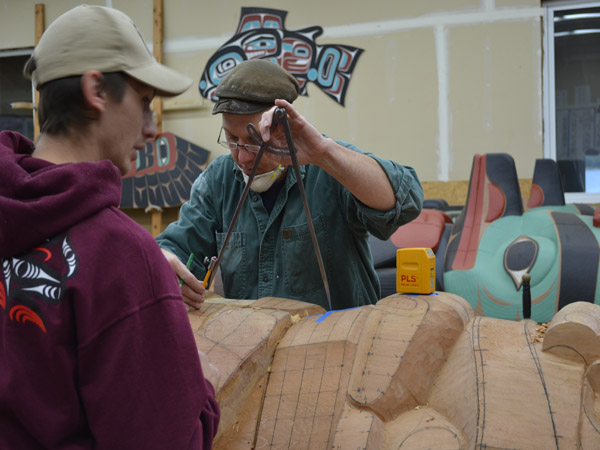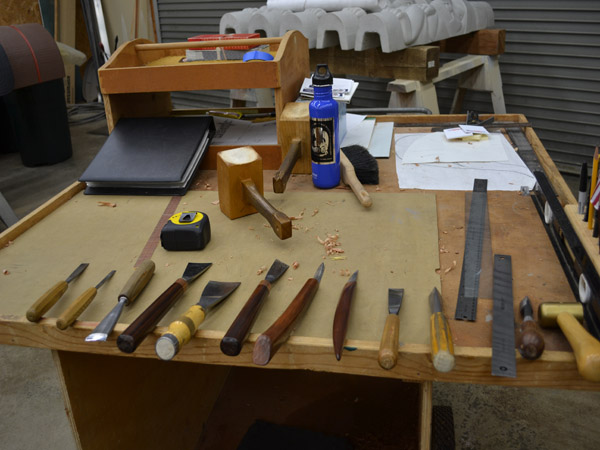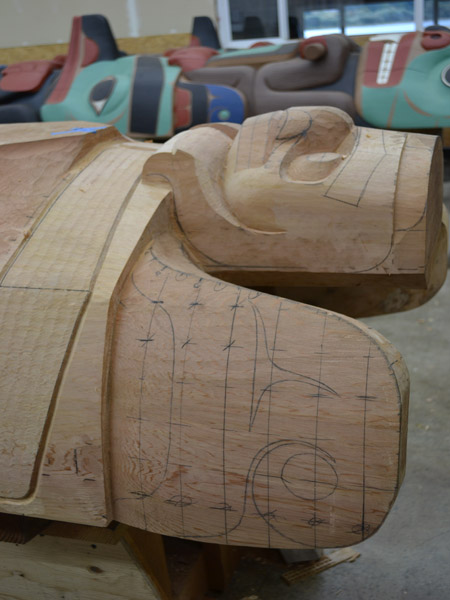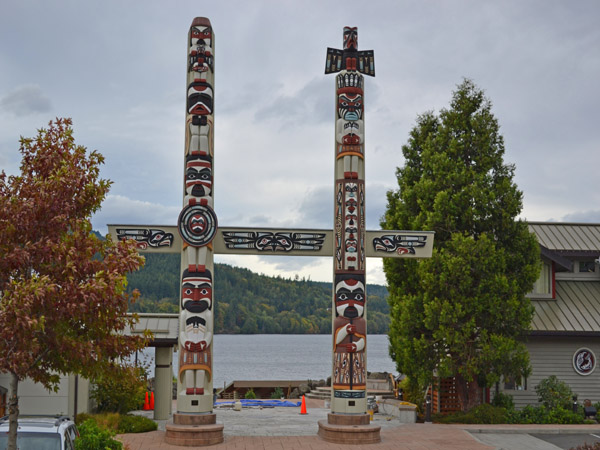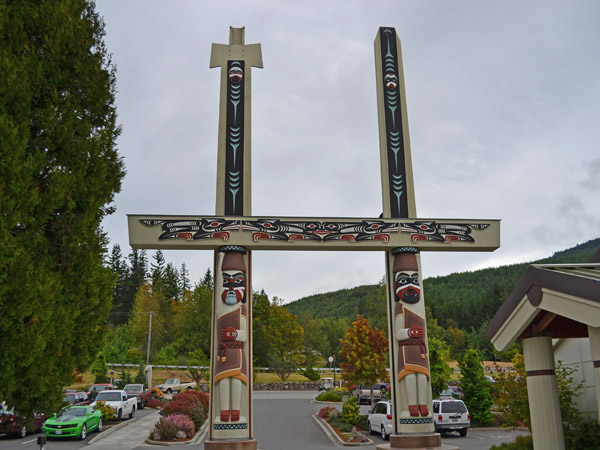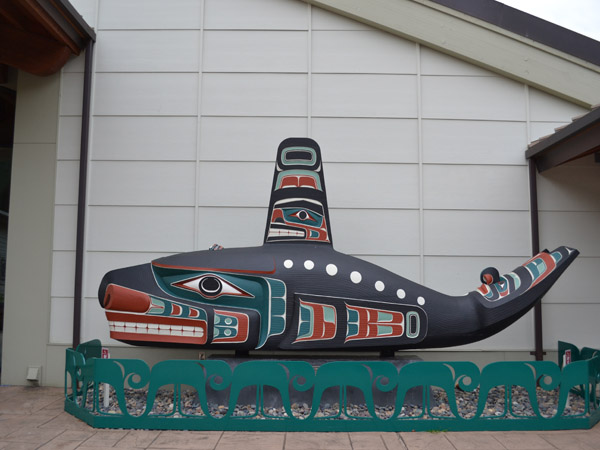Category: Art
Pumpkin Pig People
Lavenderlady (AKA Norma), the talented founder of this blog, previously posted images of this local couple that quietly holds court at Sunny Farms around this time of the year. As with us all, they change fashion a little from year to year. Miraculously, they don’t seem to age much. Here they are this year, settled into a little pumpkin pig love nest outside the store.
Here they are in 2008 and here they are in 2009.
Sunny Farms was recently named in a couple of categories of “Best of the Peninsula.” We’ll revisit tomorrow to see what honors they took.
Cool bear
Totem carving 2
Here is a view of the Blyn carving shed of the S’Klallam Tribe. In addition to the huge, hefty cedar logs used for totems, the carvers also render in foam. Two such pieces are on the wall to the left. This allows them to create lightweight pieces was wall hangings. In the center above are two cast totems that have been designed for the Tribe to sell as commercial products.
The cast totems tell the story of the “Bear of Heaven,” from Nuxalk mythology where the House of Myths is the dwelling pace of supernatural beings that influence the natural phenomena of the world in which we live. The “Bear of Heaven,” Nusme’ta acts as a guardian of the Path of the Sun. The sun travels on a bridge; where he walks on the bridge explains the varying height of the sun during the year. One of Nusme’ta’s duties is to assure that the sun does not tarry too long at the Solstice. The Bear of Heaven totems will sell for $250 unpainted. The cost for a painted totem had not been calculated when I visited.
This is Dale Faulstich, the artist who has designed and carved the S’Klallam totems I’ve shown you over the past week. Dale has worked for the Tribe for over 20 years and has translated its history and cultural heritage into the poles that now grace Tribe’s properties. The carving shed where Dale and the other carvers work is open Mondays through Fridays and Dale was very gracious in telling us about the totems and how they are made. I’m sorry to admit that I did not get the names of the other carvers I have pictured.
Click here for more information about the Jamestown S’Klallam tribe and here for a link through the Jamestown gift shop or here for a link through Amazon for information about “Totem Poles of the Jamestown S’Klallam Tribe” which describes the poles and their tales more fully.
I’ve enjoyed sharing these photos and what I’ve learned about the local totem poles and hope it has interested you, too. I have not shown you all of them yet and plan to bring more pictures of them to the Sequim Daily Photo in coming months. Stay tuned!
Totem carving
The totem poles erected by the S’Klallam Tribe are creations that celebrate a contemporary culture. In addition to their tribal operations, the S’Klallam operate a casino, a convenience store, deli, gas station, art gallery, construction and excavating companies, and they recently opened a community health center. Above is a carving shed where their totem poles are created.
Below is a workbench with tools in current use. More tools are stored elsewhere in the shop. The carvers at the top of this page are transferring the design onto the wood with a compass. They use tools that most contemporary carvers would recognize: adzes, chisels, gouges, and carving knives, even a laser level — the little yellow instrument above marked “PLS.”
The pole that’s being worked on here is similar to a traditional mortuary pole. It will contain the ashes of the wife of a man who has independently commissioned it. A typical full sized totem pole is carved from a Western Red Cedar tree that is generally 500-900 years old. Trees were once harvested from the western rainforests of Clallam County; carvers for the S’Klallam now go afield to British Columbia and Alaska — or anywhere they can get trees of the right size. The totem workshop is fragrant with the smell of cedar and the rings of the pole being worked on were so tight that counting them would be a bit like measuring sand on a beach.
The Tribal Council must approve all totem pole designs. The 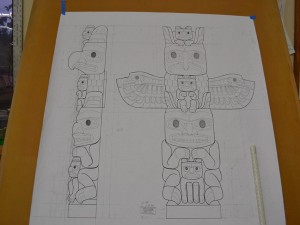 drawing at left shows the design, I believe, of the pole that is being created — I did not confirm that with the carvers.
drawing at left shows the design, I believe, of the pole that is being created — I did not confirm that with the carvers.
Depending on the size and complexity of the design, a typical totem pole can take from four to six months to complete.
Below is the top of the new totem. You can see its form taking shape as well as features that will be carved from the wood. Beyond the new carving are two completed totems that are destined for the Blyn Fire Station that the tribe has built. It is adjacent to their gas station and convenience store. The totems will be erected after the excavation and foundations have been completed for their placement.
The poles can weigh 2,000 pounds. They are placed today with the aid of a crane hoist and supported by steel. A traditional pole would have been raised using a tripod of long poles. I hope to attend the dedication ceremony of the Blyn Firehouse poles. If I do, I’ll take pictures and post information about that.
Tomorrow: Meet Dale Faulstich, artist and carver for the S’Klallam Tribe, and see more of the carving shop.
Totem poles 6
There is a dance plaza at the S’Klallam Tribal Center where these two totem poles stand. They overlook Sequim Bay and are called the “Strong People House Posts.” The S’Klallam people are known as “the Strong People” and this is an adaptation of the story the poles tell:
Faced with the task of lifting a particularly heavy house post the tribes of the area once gathered. One by one, groups from each tribe tried to heft the huge log and, one by one, they failed.
The S’Klallam people considered the problem. They rolled the long pole into the water of Sequim Bay. As the log began to float, their strongest men stooped in the water to put their shoulders underneath. Then they stood, and by their combined strength they lifted the pole from the water and carried it to its place. From that day, the S’Klallam have been known as “the Strong People.”
This is the back of the Dance Plaza poles. These poles commemorate the 1874 tribal actions in acquiring the Jamestown lands that I told you about yesterday.
Most of the information I have posted about all of the S’Klallam totem poles has been taken from a beautiful and interesting book entitled “Totem Poles of the Jamestown S’Klallam Tribe: The Art of Dale Faulstich” (available — where else? — on Amazon.com and also at some local Sequim outlets). It contains many stories told by Tribal Elder and storyteller Elaine Grinnell and far more detail than I can share in my posts.
Tomorrow I’ll take you into the carving shed of the Tribe and show you a carving project.
Totem poles 5
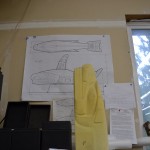 S’Klallam tribal art is not confined to totem poles. There is a carved rendition of a killer whale located at the north campus of the S’Klallam Tribal Center in Blyn. To the right are drawings of the piece as planned and a foam carving of its front end. The photo is taken in the Tribe’s Carving Shed. Below is the finished piece as it stands today.
S’Klallam tribal art is not confined to totem poles. There is a carved rendition of a killer whale located at the north campus of the S’Klallam Tribal Center in Blyn. To the right are drawings of the piece as planned and a foam carving of its front end. The photo is taken in the Tribe’s Carving Shed. Below is the finished piece as it stands today.

